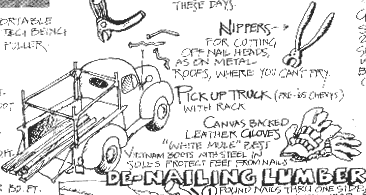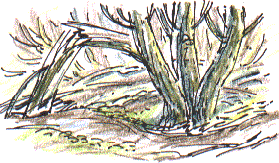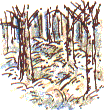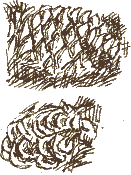 'My
main focus all along,' writes Dan Price in his latest
book, Radical Simplicity, ' has been to somehow dodge all those
lassoes being thrown by that darn cowboy called life . . . I'm trying
to ignore all the societal pressures that try to define who I'm supposed
to be or what is deemed successful. I'd like to just honor our sacred
earth by becoming so small, so quiet, and so unsubstantial that the
environment I inhabit feels barely a whisper of my miniscule existence
. . . In this way nature is free to express itself fully while I try
to comprehend and appreciate its vast universal rhythms . . . ' 'My
main focus all along,' writes Dan Price in his latest
book, Radical Simplicity, ' has been to somehow dodge all those
lassoes being thrown by that darn cowboy called life . . . I'm trying
to ignore all the societal pressures that try to define who I'm supposed
to be or what is deemed successful. I'd like to just honor our sacred
earth by becoming so small, so quiet, and so unsubstantial that the
environment I inhabit feels barely a whisper of my miniscule existence
. . . In this way nature is free to express itself fully while I try
to comprehend and appreciate its vast universal rhythms . . . '
 This
has been the perfect book to read at the start of a new year; it's inspired
me to get out to experience and to draw nature in a direct way again (not
that I needed much of a push there), and it has set me rethinking some
the accepted values and goals which we allow to rule our lives. This
has been the perfect book to read at the start of a new year; it's inspired
me to get out to experience and to draw nature in a direct way again (not
that I needed much of a push there), and it has set me rethinking some
the accepted values and goals which we allow to rule our lives.
Thoughtful and funny, perceptive and practical, Radical Simplicity
is a delightfully subversive approach to the great American dream
of freedom and the pursuit of happiness.
Shelter in the Seventies

Drawing by Bob Easton from an article on Wrecking and Salvage
from Shelter 6,
Shelter Publications, 1973.
|
Dan recalls the Shelter books, published in the 1970s,
were an early inspiration. I've just taken my copy of Shelter
6 from the shelf and found, amongst the eclectic mix of photographs,
drawings and plans of hand-made buildings from around the world,
a handful of examples of clear, quirky artwork by Bob Easton,
Joaquin de la Luz and others in the folksy idiom
that I associate with Price.
I was an art student in those heady days of Shelter, Domebook,
the Whole Earth Catalog and A Blueprint for Survival.
We'd have a safer, more sustainable world if those ideas had
been wholeheartedly taken on board. At the time, I got as far as
considering a vague scheme to construct a small geodesic dome greenhouse
to grow tomatoes in our back garden but it never got started, partly
because I couldn't puzzle out how I'd make all those 72° joints.
Meanwhile Dan, who was then still at school, had already starting
experimenting with various shelters built from a range of natural
materials on the wooded mountain behind his house. |
A Walk in the Woods
  A
half-hour's walk up Coxley Valley takes you through several
different kinds of woodland but first there's a big housing development
to go by - there goes another meadow, *sigh* - and the stump of the stream-side
Ash, felled by the developers at the top of the steep
bank. The stump is sprouting Honey Fungus but fresh shoots
are springing up from its edges. A
half-hour's walk up Coxley Valley takes you through several
different kinds of woodland but first there's a big housing development
to go by - there goes another meadow, *sigh* - and the stump of the stream-side
Ash, felled by the developers at the top of the steep
bank. The stump is sprouting Honey Fungus but fresh shoots
are springing up from its edges.
 There
are Crack Willows (left) by the stream as you
walk on past the old quarry then, on the drier ridge beyond the dam, Sessile
Oak is dominant. On rolling slopes below Netherton cemetery there
are extensive birch woods with the odd isolated old sweet
chestnut tree standing amongst them; a curious survivor from
- to judge by their gnarled character - plantings made more than a century
ago. There
are Crack Willows (left) by the stream as you
walk on past the old quarry then, on the drier ridge beyond the dam, Sessile
Oak is dominant. On rolling slopes below Netherton cemetery there
are extensive birch woods with the odd isolated old sweet
chestnut tree standing amongst them; a curious survivor from
- to judge by their gnarled character - plantings made more than a century
ago.
The View from South Lane
  I
take the old bridleway out of the woods at their south east corner to
enjoy the contrast of striding along a small country lane, South
Lane, Netherton, with views through the hedgerow trees across
the lower Calder Valley towards the Vale of York. The freshly painted
orange and cream tower-blocks of Wakefield give an off-the-shelf look
to Wakefield, five or six miles away, while the distant cooling towers
of Ferrybridge and Drax steam away in the distance. I
take the old bridleway out of the woods at their south east corner to
enjoy the contrast of striding along a small country lane, South
Lane, Netherton, with views through the hedgerow trees across
the lower Calder Valley towards the Vale of York. The freshly painted
orange and cream tower-blocks of Wakefield give an off-the-shelf look
to Wakefield, five or six miles away, while the distant cooling towers
of Ferrybridge and Drax steam away in the distance.
The pine cones, right, are part of my mum's
Christmas decorations. 
Richard Bell, richard@willowisland.co.uk |